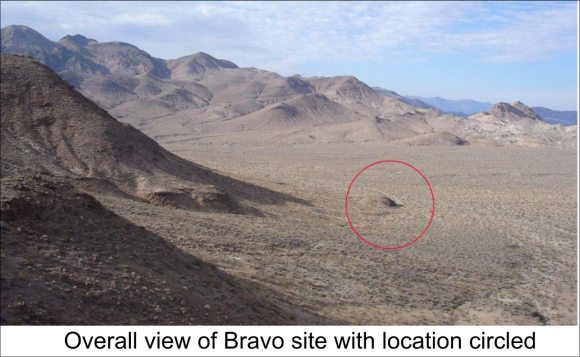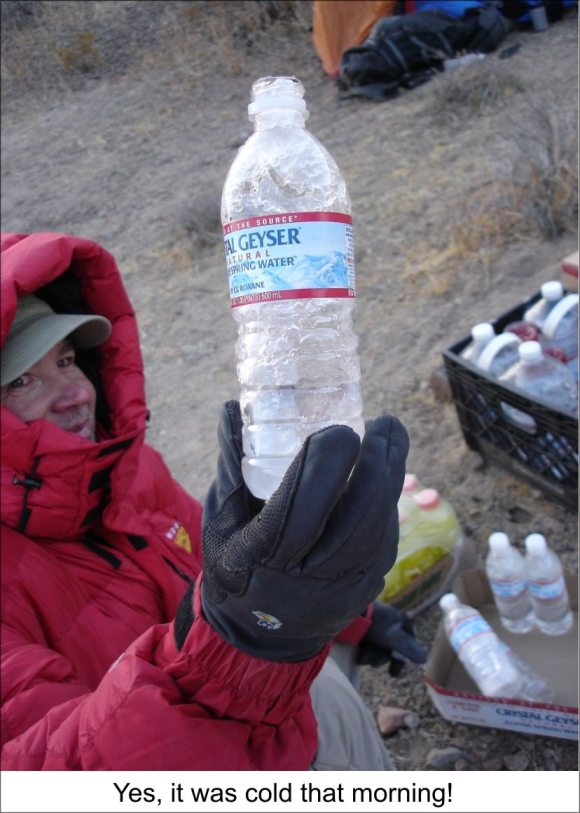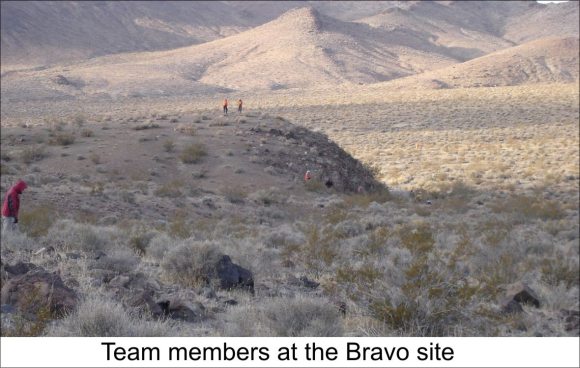Evidence Search for Missing German Tourists in Death Valley
|
December 4-6, 2009 |
Written by Tom Mahood
On the morning of Friday December 4th, an eight person team of RMRU members left Hemet for the ghost town of Ballarat to participate in a joint agency search effort for evidence of four German tourists who disappeared in Death Valley in July of 1996. Their van had been discovered stuck in a remote wash in October of 1996, and other than a beer bottle found 1.7 miles downstream of the van, not a trace of them had ever been found. That is until November 12, 2009, when RMRU team members Tom Mahood and Les Walker discovered human remains, personal effects and identification of a member of their party in a very remote location southerly of where their rental van was found. This new search was being performed to seek further evidence and bring full closure to a thirteen year old mystery.
The RMRU team consisted of Lee Arnson, Pete Carlson, Lew Kingman, Tom Mahood, Chad Marler, Tom Marshall, Nick Nixon and Les Walker. We arrived at the command post, a campground at the ghost town of Ballarat, just before dark and set up camp. Shortly after dark, wonderful food was rolled out and a briefing was held for all the teams.
This search, planned and run by the Inyo Sheriff’s Office, was being done as an OES search. “OES” means the California Office of Emergency Services and is a state-coordinated mutual aid arrangement which allows for the bringing in of additional resources, which in this case meant additional search teams. Search teams represented included Inyo SAR, China Lake Mountain Rescue Group, RMRU, San Bernardino Desert Rescue, Calaveras County SAR and Death Valley National Park. In all, about 27 people and three dogs would be in the field actively searching, and perhaps another dozen personnel were involved in running the command posts, driving and other support operations.
This mission, challenging in itself, had two unusual aspects. First, while we were being inserted by helicopters, we had to walk out on our own. Second, our departure point was on the other side of the Panamint Mountain range from where we arrived at Ballarat with our vehicle, requiring a 120 mile vehicle shuttle. Tom Marshall was to be the driver of the RMRU vehicle and assisted with command post duties while the remainder of the team was in the field. Tom ended up doing the long trip several times, helping to move other team’s vehicles also.
The mission plan was to begin first thing Saturday morning (December 5th) inserting a variety of teams via a pair of borrowed Homeland Security helicopters at three locations, comprising two search areas (Alpha and Bravo). Landing zone (LZ) Bravo was adjacent to the spot the remains were found by Les and I just over three weeks earlier. Teams inserted in this area would be doing a detailed search of the upper alluvial fan around the remains and also the canyons running north, eventually moving back down to Anvil Canyon (where the van had been found) and westerly out to the trailhead at Willow Spring. From there they would be picked up and transported to a secondary command post operating at a stone cabin in Butte Valley. Nick and Lew were part of a Bravo ground team and Chad made up half of a dog team.
The other two LZs, Alpha1 and Alpha2, were about 4 miles further to the
south of the Bravo LZ. Teams inserted at these locations were to search
southerly to the boundary of the China Lake Naval Weapons Center, then
turn back north and search the three possible southerly routes down from
where the remains were found and continue to the Bravo LZ. All teams would
camp for the night there, as additional water was being placed at that
location via helicopter. Any evidence found was to be flagged with surveyor’s
tape, photographed, marked with GPS and left in place for later retrieval
by Inyo Sheriff’s forensic staff. Lee, Pete and I were assigned
to the easterly Alpha area LZ. Les Walker was also assigned to this LZ
as part of a dog team.
It was a cold night in Ballarat, but early next morning we were packed and ready to go. The first helicopter out carried the radio repeater, and the second helicopter carried Lee and Pete (during the first flights of the day the helicopters had extra fuel so their carrying capacity was limited). I went out on the third helicopter flight, along with Les Walker, a dog and his handler.
Lee, Pete and I were dropped only about 1-1/2 miles north of the China Lake military border, so we decided to leave our heavy packs at the LZ, and head south with just the basics to do some searching. Les and his dog handler went off in whatever direction the dog felt like. After about an hour we reached the China Lake NWC border, seeing nothing other than an intriguing old beer can (which was retrieved as a possible clue).
Seeing nothing, we turned north and reluctantly started the long uphill
climb back to our packs and on to the planned camp at the Bravo LZ. Our
task along the way was to search the easterly drainage of the upper alluvial
area. Almost the entire upper area drained down through the very large
wash we were travelling up. If there were any clues to be found here,
it was likely they would have been churned to oblivion.
While we were busy in the south, the Bravo teams (including Nick, Lew
and Chad) were still waiting for helicopter insertion. Because of helicopter
delays, they weren'’t able to make it to the Bravo area until late
Saturday afternoon, leaving not much time for searching. But they were
able to perform some line searches looking for more evidence, as well
as go over the surrounding hillside.
We finally reached the Bravo LZ around 4:00 PM, just as it was starting to get rather cold. We knew that there was a major winter storm forecast to come in to the area in a few more days, but it seemed like the temperature was dropping well in advance. It was good to see all the others at the camp, as we had been on our own most of the day. It was even better to see the pallet of water and energy drinks! As a point of reference, Pete Carlson, an adventurer and climber all his life remarked, "This is the most remote place I've ever been". That pretty much sums it up!

Before it got dark a few of us had a quick look around to see what had
changed at the site since Les and I had last been there. It seemed like
whoever had been there after us to collect evidence had done a good job,
as there was little to be found. I say “seemed” because as
we looked a little closer, we suddenly noted a number of other scattered
skeletal pieces on the cliff and off to the side. Clearly there was more
here.
At the team’s briefing that evening at the Bravo LZ, it was decided
all the team members present at the Bravo LZ would take a couple of hours
in the morning to scour the immediate area and hillside for more evidence
before departing the area around 9:30 or 10 AM. We knew we had a long,
11 mile trek out, so we didn’t want to linger too long, but there
was obviously more evidence to be marked.
That night was an amazingly cold night. This being Death Valley, many of us brought “summer bags”, sleeping bags comfortable down to perhaps 30 degrees. Combined with the shelter of a tent, that should have kept us reasonably comfortable. I say “should have”, because it most certainly didn'’t. The next morning, Sunday December 6th, someone with a thermometer reported it was 19 degrees. As we poured water from the cache into our pack’'s water bladders, it started flash freezing and turned to slush before our eyes. Great way to start the day!

But the cold temps made the heat-generating act of walking around the
hillside quite pleasant and welcome. Beyond that, it was very useful,
as numerous additional remains were found and marked. The hillside was
now ablaze in fluorescent red tape streamers.

Finally, it was nearing 10 AM and it was time to depart. We were warned
via radio that the storm had moved up and was now expected to hit that
night, so we were all maybe a bit more eager than usual to leave. Some
of the Bravo teams (including Nick and Lew) had already left, heading
due north to Anvil Canyon, before turning westerly to exit. They would
be checking a couple of canyons on the way. The rest of us, mostly from
the Alpha area LZs, were taking a more direct route and headed up and
across the alluvial fan to the northwest, a quicker route out. From there
we dropped into the canyon that would take us most of the way towards
Anvil Canyon. But to save distance we veered off to the left before we
reached Anvil Canyon, and headed cross country until we dropped into Anvil
Canyon closer to the trailhead. Lee, Pete, Les and I seemed to be toward
the front of the groups, and reached the head of Anvil Canyon as the wind
started to pick up to gale force. And cold gale force at that.
Wonderfully for us, there was a 4wd waiting to take us to the command post at the Stone Cabin. Reaching the cabin, we found food and hot drinks. The Inyo Sheriff’s Office had a fantastic setup going there which was welcomed immensely by all those coming in from the cold. Following a debriefing, and dumping of GPS logs and camera memories, we were cleared to leave.
Well...That’s the way it was supposed to have worked. But the RMRU team was delayed a couple of additional hours assisting another team to make it out of Anvil Canyon, due to illness of one of their members.
It was a long drive home, and we didn’'t reach our Hemet base until 12:30 AM Monday morning, after which we unpacked and headed off our respective ways.
It had been the plan of the Inyo Sheriff’s Office to send a helicopter in the next day to extract the additional remains and evidence we had found and marked so well. But the intense storm coming in was expected to dump snow on the area, making retrieval impossible for perhaps a week. Because all this well marked material would be sitting there unprotected in the interim, the Sheriff strongly urged all of us to keep all of the weekend’'s events as confidential as possible until they could retrieve the material. Considering the buzz over the case and the discussions happening on various Internet forums, it seemed like more than a reasonable request and we were all happy to comply. It turned out the forensics people weren'’t able to get back to the site until December 29th, so keeping a lid on the information turned out to be a very good idea.